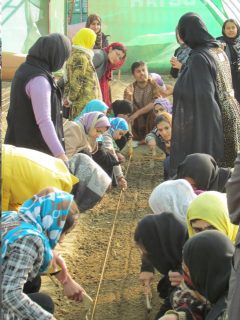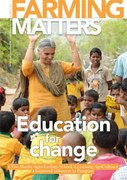Over 75 percent of Afghanistan’s population lives in rural areas, and agriculture is the country’s main economic activity. After three decades of war and political instability, agricultural education is once again playing an important role, and many young Afghans are preparing themselves to become teachers. Special efforts are being made to train women as teachers in response to one of the country’s most difficult challenges: gender inequality.
Agriculture is the backbone of Afghanistan’s economy, and is dominated by smallholders who mostly grow wheat, barley, fruits and nuts. Approximately half of the country is also used as seasonal rangelands for livestock, especially small ruminants.

However, more than thirty years of war and instability have had serious consequences on these activities, on farm infrastructure and on the institutions that support agriculture. This situation has also led to a loss and failure to renew the knowledge and skills needed to produce, innovate and adapt to changes.
One of the priorities of the Afghan government is to rebuild the agricultural education system throughout the country to ensure that young people not only get access to education, but to drive innovation in the agricultural sector as a whole. The Agricultural Technical Vocational Education Training (ATVET) project forms part of the response to this need.
Agricultural education
Afghanistan has seen the number of agricultural high schools grow from 30 in 2011 to almost 100 throughout in 2013. To support this development, the National Agriculture Education College (NAEC) was established in Kabul in 2011, providing a two-year teacher training programme for people going on to work at the agricultural high schools. NAEC has a faculty of 30 teachers, 6 of whom are women. Now in its second year, the training college has 275 students coming from 23 of Afghanistan’s 34 provinces. This year, the student body includes a group of 19 female students hoping to become teachers.
Students undergo a rigorous entrance examination. NAEC staff is finding that Afghanistan’s education system has lagged behind – not only in terms of students missing important practical skills in agriculture, but also in terms of teaching methodologies. Formal education still is mainly based around a system of learning by rote, and the learning materials are largely theoretical, based on textbooks rather than on practical farming and field exercises. The result is that if students have not grown up on a farm, they lack experience in literally “getting their hands dirty”, and find it difficult to encourage others to do the same when they become teachers.
Practical skills
A key didactic strategy in the NAEC curriculum is to develop a hands-on training process that also stimulates the future teachers to use more creative teaching methods. The school grounds contain 5 jeribs, the equivalent of one hectare of land, and include a permaculture garden and greenhouse. Students are encouraged to experiment with what they have learnt, and to compare different farming approaches, including sustainable processes like mulching and composting. Muhammad Ayaz, a current second year student at NAEC, is pleased with this approach: “At the Agriculture High Schools we studied different agriculture concepts but only theoretically. However, here at NAEC, we are ‘learning by doing’, practising pruning, grafting, growing vegetables inside and outside the greenhouse, and more. I am very happy that I can now tell people that I know about these practices.”
At the beginning of 2013, 21 of NAEC’s faculty received training in participatory teaching methods (e.g. more interactive teaching, role play, debates, field visits etc.) at the International Institute of Rural Reconstruction (IIRR) in the Philippines. NAEC’s Education and Training Advisor, Michelle Glenn, sees clear benefits in how the teachers carry these new methods into their own classrooms: “This is the first time the students at NAEC have been taught in this way: they are very enthusiastic once they get over their initial shyness in participating. In fact, our second year students are demanding even more interaction now.”
More female students
In Afghanistan, women are involved in most farming activities, including poultry and dairy production. Nevertheless, agriculture is, in general, a male domain. At present, only a few girls attend agricultural education institutions, though more and more are becoming interested in improving their knowledge and skills. Afghan society currently prefers that girls are taught by female teachers, and teaching is one of the few accepted public roles for women. To encourage higher attendance at these agricultural high schools, it is important to train more girls to become teachers at them.
Besides the problem of few female AHS graduates, other barriers stop female candidates from applying to the NAEC. One important factor is that students’ families do not want their daughters to live away from home in a dormitory. NAEC is tackling these kinds of issues in a stepwise fashion. A first decision was to focus on female candidates from the Kabul area only, so that they could still live at home. It was then decided to arrange daily transportation to the college. Another step was to create an agricultural preparatory course for the female candidates, to allow them to catch up on basic agricultural knowledge. Lastly, the group of female students are taught in classes separate from the males.
All of these efforts are paying off. After the prep course, the girls were given the same entrance exam as the rest of the student body. They ended up scoring very highly, with the lowest score being 75%, while the entry requirement was 50%. They gained a lot of respect from the rest of the students through this achievement. The group of 19 female students is very motivated. The college hopes that once these girls have shown how successful they can be, the rest of the barriers can be removed one by one. One idea for example, is to establish a female dormitory so that girls can come from other areas of the country.
These are still early days for the NAEC and the agricultural high schools. Setting up new institutions and changing societal attitudes in such an unstable and uncertain environment is fraught with challenges. Slowly but surely, a positive and remarkable change in the Afghan agricultural education system will come.
Mundie Salm and Ayesha Sabri
Ayesha Sabri is the Training and Education Director at NAEC, Kabul.
E-mail: sabri.ayesha@yahoo.com.
Mundie Salm is curriculum developer for the same project, based in Wageningen.
E-mail: mundie.salm@wur.nl
More information on this project: Improving agricultural education in Afghanistan


